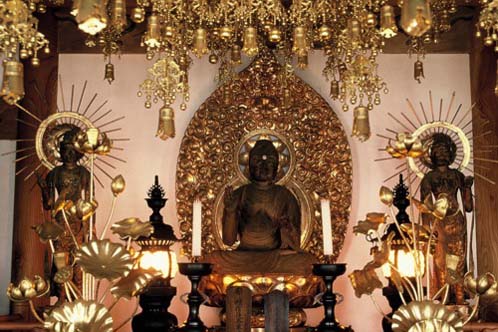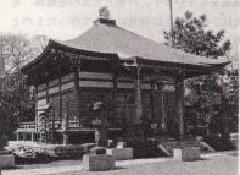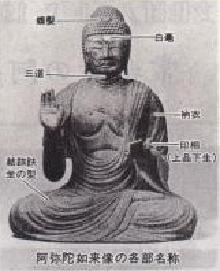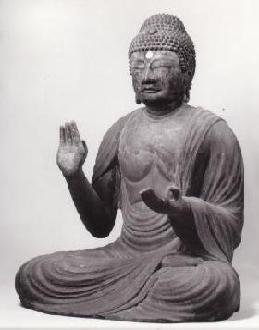Last updated: June 27, 2017

Amida triad statue at Jorakuji Temple
Jorakuji, an ancient temple of the Tendai sect in Higashi-Naganuma, is home to the Amida Triad, a cultural property designated by the Tokyo Metropolitan Government. Located in the Amida-do Hall (main hall) on the right after entering the Sanmon Gate, this is the oldest Buddhist statue in the city, along with the Koshoji Kanzeon Bodhisattva statue. It is known as.
The three Buddha statues are all made of Japanese cypress wood and are 78.4 cm tall. The Bodhisattva standing statue (Migiwakijikanzeonbosatsuryuzo) is 92.7 cm, and the left flank Bodhisattva standing statue (Hidariwakiji Seishibozatsuryuzo) is 92.3 cm.
The middle statue of Amitabha Tathagata is seated in a kekkafuza position with the right leg up (both legs crossed, with the top of each foot resting on the opposite thigh). The right hand has its palm facing forward with its first and second fingers bent, and the left hand also has its palm facing upward and its first and second fingers bent. The rahotsu (grained curly hair on the head of the Tathagata statue) is cut into a shape, and the eyes are carved. cancer). The noue goes from the right shoulder to the abdomen, and wraps around the thigh and legs. The entire body is covered with lacquer foil (gold leaf is placed on top of the lacquer), and the chest area is coated with lacquer leaf as well as the base. The flaking is noticeable.
The structure is made by carving the head and body from a single piece of wood, and inserting a chisel under the neck under the sando (three grooves on the neck). The head and body of the statue are separated, and the inside of the statue is cut out. The parts behind the ears of the head, the back of the body, the shoulder, elbow, and wrist of the right arm, and the cuff and wrist of the left arm are made of different materials.
Characteristics of the Fujiwara period can be seen in the gentle expression of the folded eyes, but the rahotsu hair is rather large, and the emon line is different. It is somewhat dense and retains the old style in that it has alternating large and small folds. It is thought to be a local piece of work dating from the first half of the 12th century.
The samurai on both sides of the Amida Nyorai statue are Kanzeon Bodhisattva statue and Seishi Bodhisattva statue. It is a standing statue. The Kanzeon Bodhisattva statue on the right flank stands upright on a pedestal, with its right hand hanging down with its palm facing forward, and its left hand bent holding a lotus flower. have. The head is tied with a topknot, and the eyes are made of carved eyes. He wears a johaku (a cloth worn from the shoulders to the sides) and a tenne (cloth), and below the waist he wears a kimono and a loincloth. Lacquer foil is applied to the cloth base as a whole.
The structure is a line that connects the back of the ear and the back of the heel, and is hollowed out in the front and back.
The Seishibodhisattva statue of the left side samurai (hidariwakiji) has almost the same form and structure as the Kannon statue, except that it stands with its right hand bent and its left hand hanging down. It is thought that the belongings, the loose part of the tenne, and the feet of both statues were made in later generations.
Ryouwakiji and Ryowakiji share similar techniques and facial expressions with Chuson, especially the unclear line of the lower eyelids, and are thought to be made by Chuson and Ichigu. You can
During the investigation, one of the five repaired wooden plaques that had been delivered to the middle statue had the following text: "In October of the 3rd year of the Joo period, Buddhist sculptor Shohei Yamaguchi '' has been confirmed as an inscription in ink. It is known that repairs were carried out in the 3rd year of the Joo era (1654) in the early Edo period.
Although all three statues are a little lacking in cosmetic beauty, the shape, body, and clothing are in good shape, and they can be said to be locally made Buddhist statues of excellent technique.

Amida-do Hall (main hall) of Joraku-ji Temple

Name of each part of Buddha statue

Seated Amida Nyorai
Inagi City Education Department Lifelong Learning Division Tel: 042-377-2121